We already described the first surprise, the appearance of the first "Great White Heron" subspecies of the Great Blue Heron on our lake. It continued to show up over a 9 day period, but as of this writing has not returned.
One evening the Great White Heron tarried in our back yard until a half hour after sunset. We thought it might spend the night. These photos, taken through the back patio window, are of poor quality but they capture the evening light and some nice poses as the heron engaged in some last-minute foraging along the lake margin.
.
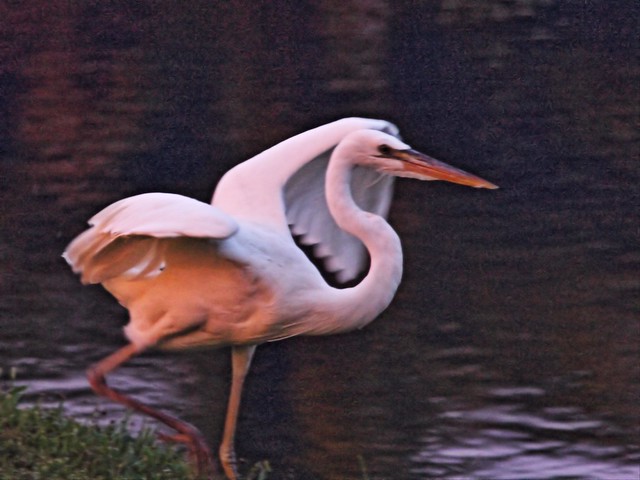
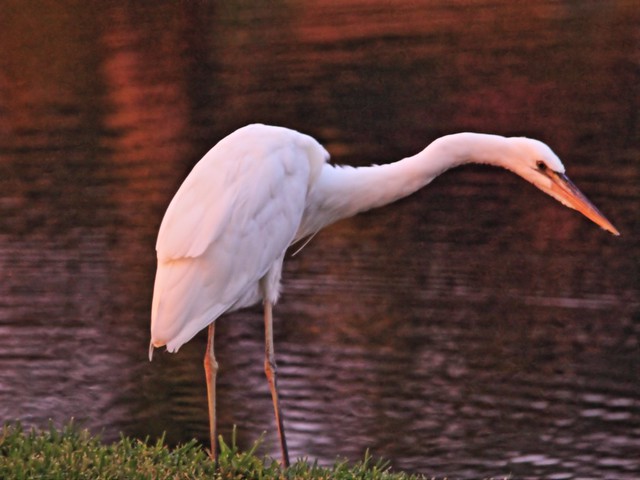
In mid-month the winds started moving in from the north, and we had several rain-free (and almost mosquito-free) mornings, allowing us to resume the habit of taking our mile walk on the gravel road into the wetlands next to our home. As usual, Mary Lou got way up ahead of me as I stopped to click a few sunrise shots.
The water level of Harbour Lake mitigation area was high, discouraging and dispersing waders.
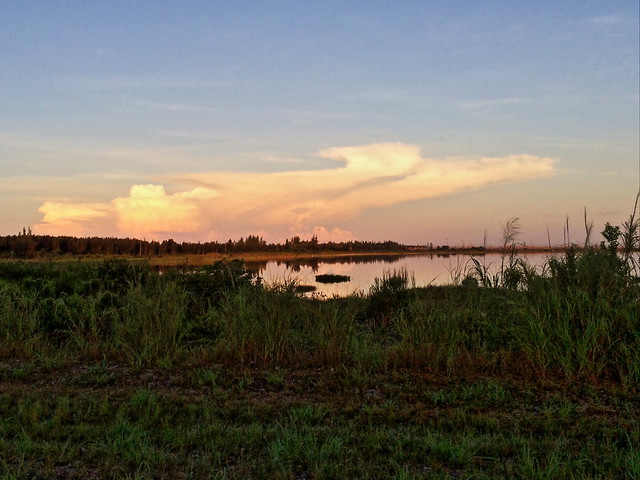
A Great Egret flew overhead.
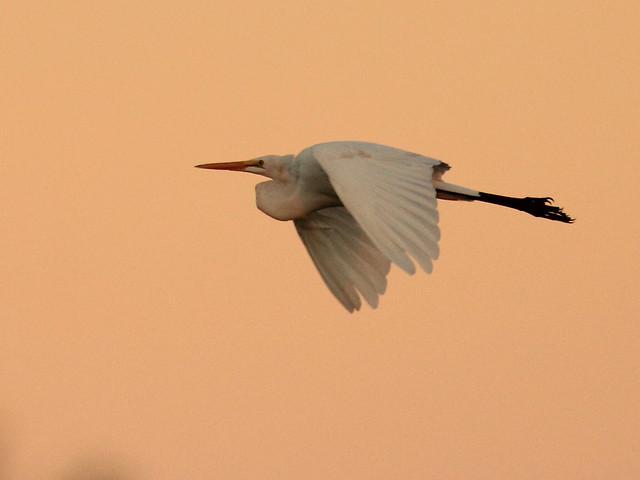
Butterflies were still dormant, soaking up the first rays before taking off, making them easy subjects. This is an almost perfect specimen of a White Peacock:
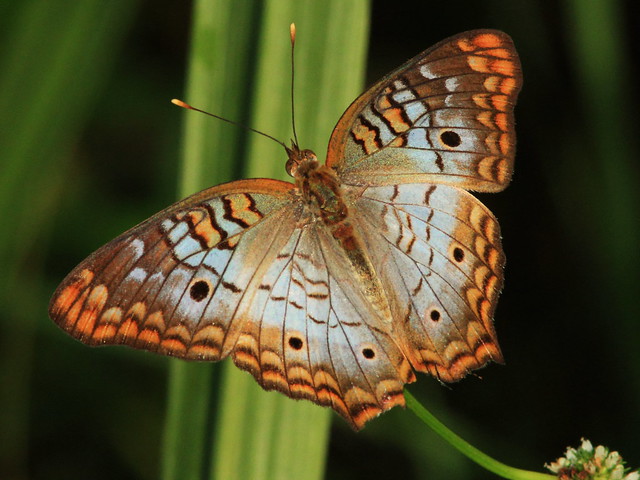
Construction of this roadway began about 12 years ago. It was designed as a 4 lane divided parkway, to connect our neighborhood (which is now isolated by the protected wetlands to the west) with points to the north and US-27, about 2 miles west of our home. Presently we must drive an extra 5 miles east, north and finally west just to access the highway. Problems in acquiring a small portion of the right-of-way and the economic downturn in 2008 delayed the project indefinitely, to our joy. Once completed it will forever change the character of the wild lands it invades.
As I ambled along the path on the edge of the gravel road, a small bird burst up from the roadside grass,only about 2 yards away, near this point on the right side of the road.
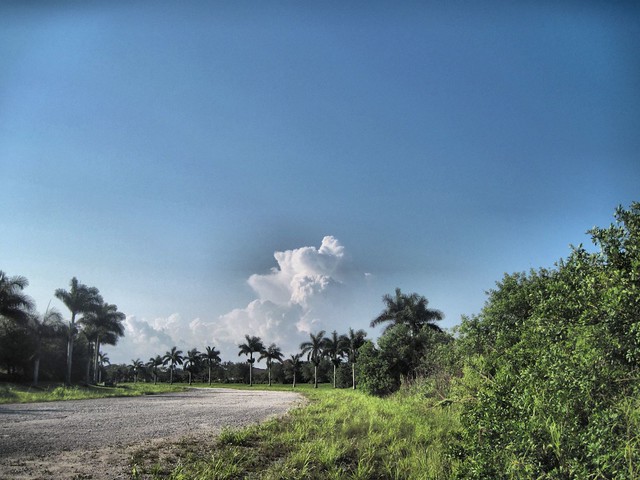
It was a female Common Ground-Dove, which retreated to the branches of a nearby tree.

I suspected that the bird had been tending a nest and I had surprised her. Not wanting to cause alarm, I made note of the location and continued walking along the road. On the way back I gave the area a wider berth, but kept a close eye on the spot from which the bird had flown. As I passed by it flew up once again.
The next morning I decided to find the nest. Keeping on the opposite side of the road, I slowly moved to within about 5 yards of the location, when my shadow startled the bird into flight. Using my telephoto lens, I scrutinized the immediate surroundings and spotted the nest, which held two very round white eggs.
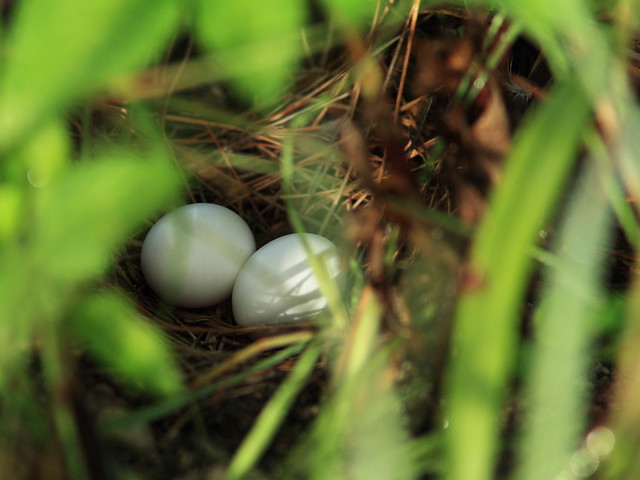
The nest, no more than a flimsy platform of grass stems, was well-concealed, on the ground at the base of a broad-leafed weed among the foot-high grasses. There has never been any doubt that this species breeds locally, but according to the Breeding Bird Survey coordinator, it was the first documented finding of a Common Ground-Dove nest in Broward County.

Although this path is commonly used by hikers, dog walkers and cyclists, I took care not to use it and also not to back-track my steps to its vicinity, but rather take my photos and continue along. I monitored the nest daily for the next nine days, hoping to note the day of hatching and possibly follow the development of the hatchlings. They are born blind and helpless but grow rapidly and are flight-ready at about 11 days of age.
Unfortunately, the landscapers began their task of "beautifying" the roadway. Their mowers had stopped only several yards short of the nest site, but when I checked the nest the next day it was empty. I believe that scavengers such as Opossums or Raccoons were attracted by the availability of rodents and snakes killed by the mowers, and they happened across the nest. It mattered little, because later that day the "landscrapers" finished their job, cutting the vegetation down to the bare ground and leaving no trace of the nest.

Following this disappointing outcome, I was heartened by a third "good thing." On a brief visit to nearby Chapel Trail Nature Preserve, we found a newly-arrived flock of over a dozen migrating Eastern Kingbirds. Among them were several first-year birds with brown backs and dark face and heads. Adults are all black above. The younger birds somewhat resemble the Gray Kingbird, but are smaller and have shorter bills. Gray Kingbirds are usually found in coastal areas, and we are 18 miles west of the Atlantic Ocean.

On our way home from Chapel Trail we stopped at a rain puddle in front of a school. It sometimes yielded waders, as I reported earlier in Life in a Puddle, but we found none. Exiting the driveway we had to wait for traffic, and I looked up and saw this bird on a wire directly overhead. Compare its bill size with that of the Eastern Kingbird, and note its black mask.

It was the first Gray Kingbird I have ever found in the western suburbs of Broward County, Florida. When I checked the eBird data I learned there had been only three reported sightings of this species in the County's inland corridor west of I-75 and east of US-27 during the past 10 years.
It eyed a passing dragonfly, but decided not to chase it.

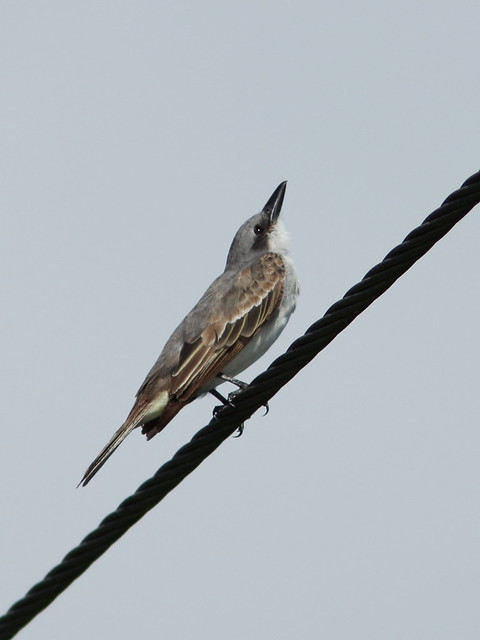
ooh, the gray kingbird is pretty! we get the easterns here, but not in huge numbers. sorry about the ground dove. what a pretty thing! love the egret in flight shot, too.
ReplyDeleteI love those Kingbirds. Great shots and a lovely post.
ReplyDeleteThis was a pleasant journey. Wonderful photos. Sad about the eggs. The Kingbird was really pretty and I liked the shots of the Heron's very much.
ReplyDeleteGorgeous birds...I always love seeing a nest! But those clouds might have stolen the show! ha.
ReplyDeleteBeautiful shots of the kingbirds. Tough luck on those eggs. Isn't it late for a new nest?
ReplyDeleteA wonderful post. I love the butterfly and the kingbirds. Too bad about the dove's nest.
ReplyDeleteLovely post and great shots.
ReplyDeleteI've been hoping to spot a ground dove here in my area....lucky you!!
ReplyDeleteBeautiful images. Yep, we've also experienced a very hot and humid August. I'm hoping that will change as the month does in a day.
Thanks for linking to I'd Rather B Birdin' this weekend...it's always appreciated!!
@Dina-- Yes, this nest is towards the late end of their very extended breeding season. In South Florida they may raise multiple broods In Florida they nest between early February through early October. Availability of seed crops influences timing. They feed their young "crop milk" which is secreted by their crop, but if food is abundant they will continue to produce broods. (OK, you asked me what time it is, and I told you how to build a watch!)
ReplyDeleteSplendid shots - I do like the passing dragonfly shot. The tern on the Farne Islands was a real bonus - all I wanted was good views of Puffin (which I got!) - many of the more twitcher type birders did not seem the slightest interested in anything but the tern - their loss!
ReplyDeleteCheers - Stewart M - Melbourne
Wow - gorgeous shots.
ReplyDeleteWonderful shots of the birds. I like Grey king bird.
ReplyDeleteHow exciting to see a Great White Heron! I'm sure I would have mistaken it for an egret. I admire your knowledge of birds.
ReplyDeleteWe have that problem here. Tidy minds who don't understand that wildlife needs untidy places to thrive.Good that you found the nest and although the descriptive name says a lot I can't imagine a dove or a pigeon nesting on the ground, especially with the white eggs they (normally?) have?
ReplyDeleteVery nice comparison shots of the Kingbirds.
Magnificent photography of nature's gems ~ nest one is very creatively done!
ReplyDeleteartmusedog and carol (A Creative Harbor)
Great series of photos, the Kingbird is fascinating.
ReplyDeleteSuch a sad outcome for the pretty Ground Dove's nest. The kingbirds are beautiful.
ReplyDeleteGorgeous kingbirds and butterfly. All lovely photos and a great variety.
ReplyDeleteThe gray kingbird is very nice!! Also loved your shots of the white heron in the sunset light! As for the dove nest...first of all, I never knew they nested on the ground! Secondly, this report saddened me so much! I hate those awful machines they come through with to cut back the foliage from the road. That isn't a MAIN road, so leave it be! They always hack everything up and make it ugly, and obviously disturb the wildlife (as well as the wildflowers!) Hate it, hate it!
ReplyDeleteVery cool find. I always forget that there is a Gray Kingbird. That would be a great find and congrats on finding one! As for the mosquitoes....don't even get me started.....
ReplyDelete